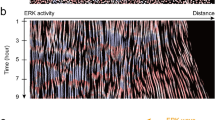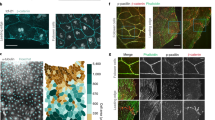Abstract
A fundamental feature of multicellular organisms is their ability to self-repair wounds through the movement of epithelial cells into the damaged area. This collective cellular movement is commonly attributed to a combination of cell crawling and ‘purse-string’ contraction of a supracellular actomyosin ring. Here we show by direct experimental measurement that these two mechanisms are insufficient to explain force patterns observed during wound closure. At early stages of the process, leading actin protrusions generate traction forces that point away from the wound, showing that wound closure is initially driven by cell crawling. At later stages, we observed unanticipated patterns of traction forces pointing towards the wound. Such patterns have strong force components that are both radial and tangential to the wound. We show that these force components arise from tensions transmitted by a heterogeneous actomyosin ring to the underlying substrate through focal adhesions. The structural and mechanical organization reported here provides cells with a mechanism to close the wound by cooperatively compressing the underlying substrate.
This is a preview of subscription content, access via your institution
Access options
Subscribe to this journal
Receive 12 print issues and online access
$209.00 per year
only $17.42 per issue
Buy this article
- Purchase on Springer Link
- Instant access to full article PDF
Prices may be subject to local taxes which are calculated during checkout





Similar content being viewed by others
References
Shaw, T. J. & Martin, P. Wound repair at a glance. J. Cell Sci. 122, 3209–3213 (2009).
Sonnemann, K. J. & Bement, W. M. Wound repair: Toward understanding and integration of single-cell and multicellular wound responses. Annu. Rev. Cell Dev. Biol. 27, 237–263 (2011).
Cordeiro, J. O. V. & Jacinto, A. N. The role of transcription-independent damage signals in the initiation of epithelial wound healing. Nature Rev. Mol. Cell Biol. 14, 249–262 (2013).
Crosby, L. M. & Waters, C. M. Epithelial repair mechanisms in the lung. Am. J. Physiol. Lung Cell. Mol. Physiol. 298, L715–L731 (2010).
Arwert, E. N., Hoste, E. & Watt, F. M. Epithelial stem cells, wound healing and cancer. Nature Rev. Cancer 12, 170–180 (2012).
Kuipers, D. et al. Epithelial repair is a two-stage process driven first by dying cells and then by their neighbours. J. Cell Sci. 127, 1229–1241 (2014).
Davidson, L. A., Ezin, A. M. & Keller, R. Embryonic wound healing by apical contraction and ingression in Xenopus laevis. Cell Motil. Cytoskeleton 53, 163–176 (2002).
Anon, E. et al. Cell crawling mediates collective cell migration to close undamaged epithelial gaps. Proc. Natl Acad. Sci. USA 109, 10891–10896 (2012).
Klarlund, J. K. Dual modes of motility at the leading edge of migrating epithelial cell sheets. Proc. Natl Acad. Sci. USA 109, 15799–15804 (2012).
Tamada, M., Perez, T. D., Nelson, W. J. & Sheetz, M. P. Two distinct modes of myosin assembly and dynamics during epithelial wound closure. J. Cell Biol. 176, 27–33 (2007).
Abreu-Blanco, M. T., Verboon, J. M., Liu, R., Watts, J. J. & Parkhurst, S. M. Drosophila embryos close epithelial wounds using a combination of cellular protrusions and an actomyosin purse string. J. Cell Sci. 125, 5984–5997 (2012).
Martin, P. & Lewis, J. Actin cables and epidermal movement in embryonic wound healing. Nature 360, 179–183 (1992).
Bement, W. M., Forscher, P. & Mooseker, M. S. A novel cytoskeletal structure involved in purse string wound closure and cell polarity maintenance. J. Cell Biol. 121, 565–578 (1993).
Jacinto, A., Woolner, S. & Martin, P. Dynamic analysis of dorsal closure in Drosophila: From genetics to cell biology. Dev. Cell 3, 9–19 (2002).
Hutson, M. S. et al. Forces for morphogenesis investigated with laser microsurgery and quantitative modeling. Science 300, 145–149 (2003).
Antunes, M., Pereira, T., Cordeiro, J. V., Almeida, L. & Jacinto, A. Coordinated waves of actomyosin flow and apical cell constriction immediately after wounding. J. Cell Biol. 202, 365–379 (2013).
Fenteany, G., Janmey, P. A. & Stossel, T. P. Signaling pathways and cell mechanics involved in wound closure by epithelial cell sheets. Curr. Biol. 10, 831–838 (2000).
Omelchenko, T., Vasiliev, J. M., Gelfand, I. M., Feder, H. H. & Bonder, E. M. Rho-dependent formation of epithelial ‘leader’ cells during wound healing. Proc. Natl Acad. Sci. USA 100, 10788–10793 (2003).
Roure, O. D. et al. Force mapping in epithelial cell migration. Proc. Natl Acad. Sci. USA 102, 2390–2395 (2005).
Poujade, M. et al. Collective migration of an epithelial monolayer in response to a model wound. Proc. Natl Acad. Sci. USA 104, 15988–15993 (2007).
Trepat, X. et al. Physical forces during collective cell migration. Nature Phys. 5, 426–430 (2009).
Meghana, C. et al. Integrin adhesion drives the emergent polarization of active cytoskeletal stresses to pattern cell delamination. Proc. Natl Acad. Sci. USA 108, 9107–9112 (2011).
Cochet-Escartin, O., Ranft, J., Silberzan, P. & Marcq, P. Border forces and friction control epithelial closure dynamics. Biophys. J. 106, 65–73 (2014).
Serra-Picamal, X. et al. Mechanical waves during tissue expansion. Nature Phys. 8, 628–634 (2012).
Tan, J. L. et al. Cells lying on a bed of microneedles: An approach to isolate mechanical force. Proc. Natl Acad. Sci. USA 100, 1484–1489 (2003).
Saez, A. et al. Traction forces exerted by epithelial cell sheets. J. Phys. Condens. Matter 22, 194199 (2010).
Reffay, M. et al. Interplay of RhoA and mechanical forces in collective cell migration driven by leader cells. Nature Cell Biol. 16, 217–223 (2014).
Kim, J. H. et al. Propulsion and navigation within the advancing monolayer sheet. Nature Mater. 12, 856–863 (2013).
Vedula, S. R. K. et al. Emerging modes of collective cell migration induced by geometrical constraints. Proc. Natl Acad. Sci. USA 109, 12974–12979 (2012).
Vedula, S. R. K. et al. Epithelial bridges maintain tissue integrity during collective cell migration. Nature Mater. 13, 87–96 (2013).
Dembo, M. & Wang, Y. L. Stresses at the cell-to-substrate interface during locomotion of fibroblasts. Biophys. J. 76, 2307–2316 (1999).
Wang, N. et al. Cell prestress I stiffness and prestress are closely associated in adherent contractile cells. Am. J. Physiol. Cell Physiol. 282, C606–C616 (2002).
Bastounis, E. et al. Both contractile axial and lateral traction force dynamics drive amoeboid cell motility. J. Cell Biol. 204, 1045–1061 (2014).
Lo, C. M., Wang, H. B., Dembo, M. & Wang, Y. L. Cell movement is guided by the rigidity of the substrate. Biophys. J. 79, 144–152 (2000).
Saez, A., Ghibaudo, M., Buguin, A., Silberzan, P. & Ladoux, B. Rigidity-driven growth and migration of epithelial cells on microstructured anisotropic substrates. Proc. Natl Acad. Sci. USA 104, 8281–8286 (2007).
Ng, M. R., Besser, A., Danuser, G. & Brugge, J. S. Substrate stiffness regulates cadherin-dependent collective migration through myosin-II contractility. J. Cell Biol. 199, 545–563 (2012).
Chen, H. H. & Brodland, G. W. Cell-level finite element studies of viscous cells in planar aggregates. J. Biomech. Eng. 122, 394–401 (2000).
Brodland, G. W., Viens, D. & Veldhuis, J. H. A new cell-based FE model for the mechanics of embryonic epithelia. Comput. Methods Biomech. Biomed. Eng. 10, 121–128 (2007).
Reinhart-King, C. A., Dembo, M. & Hammer, D. A. Cell–cell mechanical communication through compliant substrates. Biophys. J. 95, 6044–6051 (2008).
Angelini, T. E., Hannezo, E., Trepat, X., Fredberg, J. J. & Weitz, D. A. Cell migration driven by cooperative substrate deformation patterns. Phys. Rev. Lett. 104, 168104 (2010).
Plotnikov, S. V., Pasapera, A. M., Sabass, B. & Waterman, C. M. Force fluctuations within focal adhesions mediate ECM-rigidity sensing to guide directed cell migration. Cell 151, 1513–1527 (2012).
Roca-Cusachs, P., Sunyer, R. & Trepat, X. Mechanical guidance of cell migration: Lessons from chemotaxis. Curr. Opin. Cell Biol. 25, 543–549 (2013).
Behrndt, M. et al. Forces driving epithelial spreading in zebrafish gastrulation. Science 338, 257–260 (2012).
Fernandez-Gonzalez, R. & Zallen, J. A. Wounded cells drive rapid epidermal repair in the early Drosophila embryo. Mol. Biol. Cell 24, 3227–3237 (2013).
Yeung, T. et al. Effects of substrate stiffness on cell morphology, cytoskeletal structure, and adhesion. Cell Motil. Cytoskeleton 60, 24–34 (2005).
Colombelli, J., Grill, S. W. & Stelzer, E. H. K. Ultraviolet diffraction limited nanosurgery of live biological tissues. Rev. Sci. Instrum. 75, 472–478 (2004).
Acknowledgements
We thank M. Bintanel and F. Margadant for technical assistance and P. Roca-Cusachs and members of the Trepat laboratory for discussions. This research was supported by Fondation pour la Recherche Médicale (E.A.), the Spanish Ministry for Economy and Competitiveness (BFU2012-38146 to X.T., Juan de la Cierva Fellowship JCI-2012-15123 to V.C.), the European Research Council (Grant Agreement 242993, X.T.), the Agence Nationale de la Recherche (ANR 2010 BLAN 1515, B.L.), the Institut Universitaire de France (B.L.), the Human Frontier Science Program (grant RGP0040/2012, B.L.), the Mechanobiology Institute of Singapore (B.L.), and the Natural Sciences and Engineering Research Council of Canada (NSERC, J.H.V. and G.W.B.).
Author information
Authors and Affiliations
Contributions
A.B., E.A., J.C., B.L. and X.T. designed experiments; A.B. and E.A. performed experiments; A.B. analysed experimental data; A.B., V.C. and J.J.M. developed computational tools for data and stress analysis; M.G. analysed micropillar data; J.C. contributed technology; V.C., J.H.V. and G.W.B. built computational models and performed simulations; A.B., E.A., V.C., J.J.M., G.W.B., B.L. and X.T. wrote the manuscript; all authors discussed and interpreted results and commented on the manuscript; B.L. and X.T. conceived and supervised the project.
Corresponding authors
Ethics declarations
Competing interests
The authors declare no competing financial interests.
Supplementary information
Supplementary Information
Supplementary Information (PDF 3257 kb)
Supplementary Movie
Supplementary Movie 1 (MOV 3373 kb)
Supplementary Movie
Supplementary Movie 2 (MOV 4723 kb)
Supplementary Movie
Supplementary Movie 3 (MOV 3200 kb)
Supplementary Movie
Supplementary Movie 4 (MOV 4787 kb)
Supplementary Movie
Supplementary Movie 5 (MOV 905 kb)
Supplementary Movie
Supplementary Movie 6 (MOV 4248 kb)
Supplementary Movie
Supplementary Movie 7 (MOV 372 kb)
Supplementary Movie
Supplementary Movie 8 (MOV 524 kb)
Supplementary Movie
Supplementary Movie 9 (MOV 966 kb)
Supplementary Movie
Supplementary Movie 10 (MOV 547 kb)
Rights and permissions
About this article
Cite this article
Brugués, A., Anon, E., Conte, V. et al. Forces driving epithelial wound healing. Nature Phys 10, 683–690 (2014). https://doi.org/10.1038/nphys3040
Received:
Accepted:
Published:
Issue Date:
DOI: https://doi.org/10.1038/nphys3040
This article is cited by
-
Computational modeling and simulation of epithelial wound closure
Scientific Reports (2023)
-
Cancer-associated fibroblasts actively compress cancer cells and modulate mechanotransduction
Nature Communications (2023)
-
Robust statistical properties of T1 transitions in a multi-phase field model of cell monolayers
Scientific Reports (2023)
-
Free and Interfacial Boundaries in Individual-Based Models of Multicellular Biological systems
Bulletin of Mathematical Biology (2023)
-
The analytical solution to the migration of an epithelial monolayer with a circular spreading front and its implications in the gap closure process
Biomechanics and Modeling in Mechanobiology (2023)



